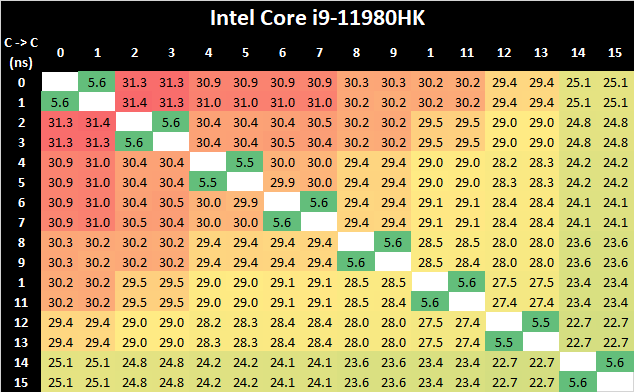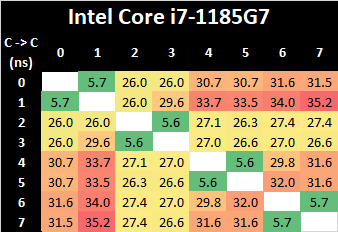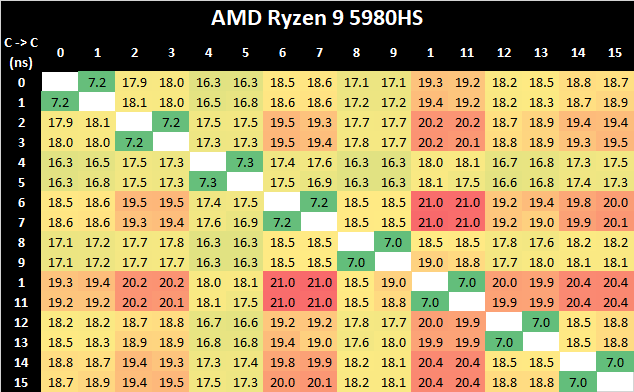Intel 11th Generation Core Tiger Lake-H Performance Review: Fast and Power Hungry
by Brett Howse & Andrei Frumusanu on May 17, 2021 9:00 AM EST- Posted in
- CPUs
- Intel
- 10nm
- Willow Cove
- SuperFin
- 11th Gen
- Tiger Lake-H
CPU Tests: Microbenchmarks
Core-to-Core Latency
As the core count of modern CPUs is growing, we are reaching a time when the time to access each core from a different core is no longer a constant. Even before the advent of heterogeneous SoC designs, processors built on large rings or meshes can have different latencies to access the nearest core compared to the furthest core. This rings true especially in multi-socket server environments.
But modern CPUs, even desktop and consumer CPUs, can have variable access latency to get to another core. For example, in the first generation Threadripper CPUs, we had four chips on the package, each with 8 threads, and each with a different core-to-core latency depending on if it was on-die or off-die. This gets more complex with products like Lakefield, which has two different communication buses depending on which core is talking to which.
If you are a regular reader of AnandTech’s CPU reviews, you will recognize our Core-to-Core latency test. It’s a great way to show exactly how groups of cores are laid out on the silicon. This is a custom in-house test built by Andrei, and we know there are competing tests out there, but we feel ours is the most accurate to how quick an access between two cores can happen.
In terms of the core-to-core tests on the Tiger Lake-H 11980HK, it’s best to actually compare results 1:1 alongside the 4-core Tiger Lake design such as the i7-1185G7:
What’s very interesting in these results is that although the new 8-core design features double the cores, representing a larger ring-bus with more ring stops and cache slices, is that the core-to-core latencies are actually lower both in terms of best-case and worst-case results compared to the 4-core Tiger Lake chip.
This is generally a bit perplexing and confusing, generally the one thing to account for such a difference would be either faster CPU frequencies, or a faster clock of lower cycle latency of the L3 and the ring bus. Given that TGL-H comes 8 months after TGL-U, it is plausible that the newer chip has a more matured implementation and Intel would have been able to optimise access latencies.
Due to AMD’s recent shift to a 8-core core complex, Intel no longer has an advantage in core-to-core latencies this generation, and AMD’s more hierarchical cache structure and interconnect fabric is able to showcase better performance.
Cache & DRAM Latency
This is another in-house test built by Andrei, which showcases the access latency at all the points in the cache hierarchy for a single core. We start at 2 KiB, and probe the latency all the way through to 256 MB, which for most CPUs sits inside the DRAM (before you start saying 64-core TR has 256 MB of L3, it’s only 16 MB per core, so at 20 MB you are in DRAM).
Part of this test helps us understand the range of latencies for accessing a given level of cache, but also the transition between the cache levels gives insight into how different parts of the cache microarchitecture work, such as TLBs. As CPU microarchitects look at interesting and novel ways to design caches upon caches inside caches, this basic test proves to be very valuable.
What’s of particular note for TGL-H is the fact that the new higher-end chip does not have support for LPDDR4, instead exclusively relying on DDR4-3200 as on this reference laptop configuration. This does favour the chip in terms of memory latency, which now falls in at a measured 101ns versus 108ns on the reference TGL-U platform we tested last year, but does come at a cost of memory bandwidth, which is now only reaching a theoretical peak of 51.2GB/s instead of 68.2GB/s – even with double the core count.
What’s in favour of the TGL-H system is the increased L3 cache from 12MB to 24MB – this is still 3MB per core slice as on TGL-U, so it does come with the newer L3 design which was introduced in TGL-U. Nevertheless, this fact, we do see some differences in the L3 behaviour; the TGL-H system has slightly higher access latencies at the same test depth than the TGL-U system, even accounting for the fact that the TGL-H CPUs are clocked slightly higher and have better L1 and L2 latencies. This is an interesting contradiction in context of the improved core-to-core latency results we just saw before, which means that for the latter Intel did make some changes to the fabric. Furthermore, we see flatter access latencies across the L3 depth, which isn’t quite how the TGL-U system behaved, meaning Intel definitely has made some changes as to how the L3 is accessed.














229 Comments
View All Comments
schujj07 - Monday, May 17, 2021 - link
You are comparing a gaming laptop against a high end professional laptop. First the 4900HS is a 35W CPU and the 10810U is a 15W CPU. If both laptops have equally size batteries, the one with the lower TDP "should" have longer battery life. On top of the the G14 has a 120Hz display and a dGPU. Both of those will pull extra power and the screen was specifically talked about in reviews of the laptop. Setting the screen to a 60Hz refresh rate instead of 120Hz significantly increased battery life. Finally the weird freezes is most likely due to the dual GPU design and switching between the iGPU and dGPU. Unless you are using so much RAM that you are page swapping.Otritus - Wednesday, May 19, 2021 - link
@schujj07 I have the same zephyrus laptop as morello159. I haven't experienced weird freezes when switching between gpus on mine, or my old laptop with an intel processor and nvidia gpu, so optimus working isn't likely to be causing the freezing. The random high power draw is a valid complaint though. I think the randomness is caused by Asus's turbo settings, which was mostly fixed by me modifying power limits and disabling turbo. But, the default experience is the processor randomly boosting ridiculously high when it should be in a near idle state and not clocking anywhere near as high. Like the chip randomly pushes all 8 cores to 3.8Ghz, when it should be running in the 1.4-1.7Ghz range.bji - Monday, May 17, 2021 - link
Why should I care AT ALL that one platform has been more stable *for you* (your words)? You are irrelevant. Just one piece of anecdotal data.Calin - Tuesday, May 18, 2021 - link
They are trading blows in performance, but AMD is doing that on 35W instead of 45W for Intel.For manufacturers that use the same chassis with Intel AND AMD processors, the Intel one will run hotter, be noisier and/or have lower battery life when working hard (I don't seem to find anything related to idle/low power consumption).
jenesuispasbavard - Monday, May 17, 2021 - link
If you're planning on further testing, maybe using Intel XTU you can limit the PL1/PL2 to 45W and see how that performs?jenesuispasbavard - Monday, May 17, 2021 - link
Maybe I should scroll to page 2 before commenting on page 1...vyor - Monday, May 17, 2021 - link
I'm sorry, but your SPECFP2017 results are just wrong. There is no possible way that the 1185G7 is faster than the 11980HK by 2x in 503.bwavesThat's just absurd, especially when every other test bar 3 shows the exact opposite results, and even of those that show similar results it isn't nearly to the same degree baring 549.fotonik, and that one has the 4900HS somehow being faster than the 5980HS.
So no, your testing is just wrong and broken.
Otritus - Monday, May 17, 2021 - link
The 1185G7 being twice as fast is a little questionable, and possibly the results for the Tiger Lake processors were switched accidentally.As to the 4900HS being faster than the 5980HS in one very specific subtest, I suppose companies have never released a new CPU architecture slower than the old one. That's why Bulldozer was well received for its incredible performance over Thuban. Rocket Lake was well loved for consistently beating Comet Lake and Zen 3 in gaming, with the 11900K always at the top of the chart. Broadwell-S of course isn't better than Skylake or competitive with Coffee Lake in gaming.
vyor - Monday, May 17, 2021 - link
Except that Zen3 is consistently faster in almost every way.Otritus - Monday, May 17, 2021 - link
Keyword "almost"Zen 3 does not win every benchmark over Zen 2, just the vast majority of them due to superior clock speeds and IPC. In 1 very specific subtest, out of all the test conducted, is it really unreasonable to see the older architecture get a win. The last time I can think of a new architecture winning every single benchmark was Conroe. Sandybridge might also get this title with workloads that didn't need more than 4 cores, but I don't exactly recall. Remember IPC is an average of performance at a given frequency, so if a few benchmarks have negative improvements in IPC, but most have large positive improvements, you can easily see a 20% IPC uplift.